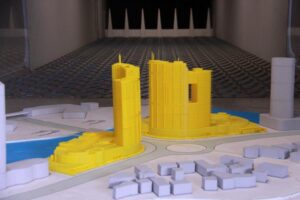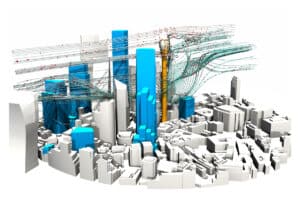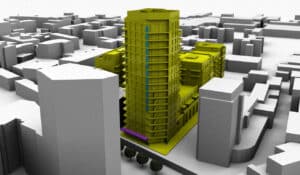Wind Environment Microclimate Studies

Case Study Example
A combination of downwash and side-streaming was creating wind speeds in excess of those suitable for a proposed outdoor dining area. Two mitigation measures were proposed including the addition of trees and shrubs to shield ground level winds and an awning to reduce downwash.
Ensuring safe and comfortable wind conditions in public and private outdoor spaces is now an essential element of the design process for all major projects. In most countries globally, the outcome of a development application hinges on the ability for the building owners and developers to demonstrate this through accurate analysis. With the dual capability of either wind tunnel testing or analysis using computational fluid dynamics (CFD), WINDTECH can advise on the most suitable methodology for your project.
By improving the human experience during the design stage, the need for remedial and expensive wind mitigations such as large screens or canopies can often be avoided.
The Gate Towers, Egypt – Wind Tunnel Model
Depending on the size, form, and location of your project, a range of studies are available, from concept through to detailed design, and if required post completion. Basic desktop or qualitative analysis provides an expert opinion of likely conditions within and around a development. More detailed analysis uses either Computational Fluid Dynamics (CFD) or physical testing in the wind tunnel to provide quantitative results. Each study aims to identify the potential adverse wind conditions in critical outdoor spaces, paying close attention to the intended use of each space. If wind conditions are seen to be unfavourable from a comfort or safety point of view, treatment strategies are recommended that are generally sympathetic to the architectural intent.
If you are interested in reading more about mitigation treatments, you may like to read our article on mitigation methods here. Our specialist and highly experienced consultants are able to reliably advise on the most suitable to use taking into consideration your project requirements.
The Tulip, London – Wind Environment CFD Wind Streamlines
Windtech Consultants played a pivotal role as the primary wind engineering experts for the Tulip Developement in London during the project’s design and planning application phase. They conducted an analysis focused on the comfort of pedestrians in relation to the wind microclimate.
This comprehencsive microclimate assessment utilised Computational Fluid Dynamics (CFD) software to effectively and efficiently evaluate the impact of different architectural configurations. The wind microclimate assessment covered all areas accessible to pedestrians within and around the project’s boundaries, in accordance with the criteria specified in the City of London Wind Microclimate Guidelines.
This included public amenity spaces, public and private terrace areas as well as private balconies. The wind microclimate study generated various visual representations, such as contour images depicting wind speeds and wind velocity vectors, offering a holistic understanding of the diverse wind effects at play.
Homerton High Street, London – Pedestrian Wind Environment Mitigation
With 30 years in the industry, WINDTECH employs world-class workflows and a high level of automation to ensure that accelerated timelines are met. Results are reliable, formatted in accordance with municipal requirements and we have a depth of experience in dealing with local authorities in the various global regions where WINDTECH operates.





